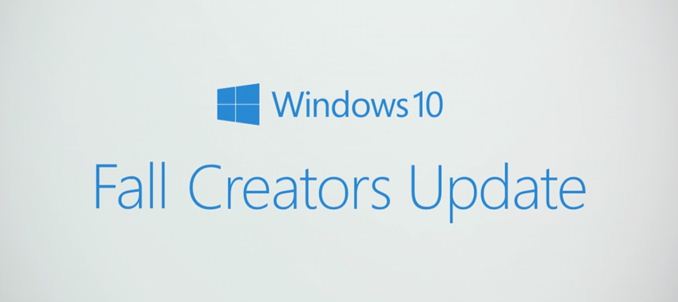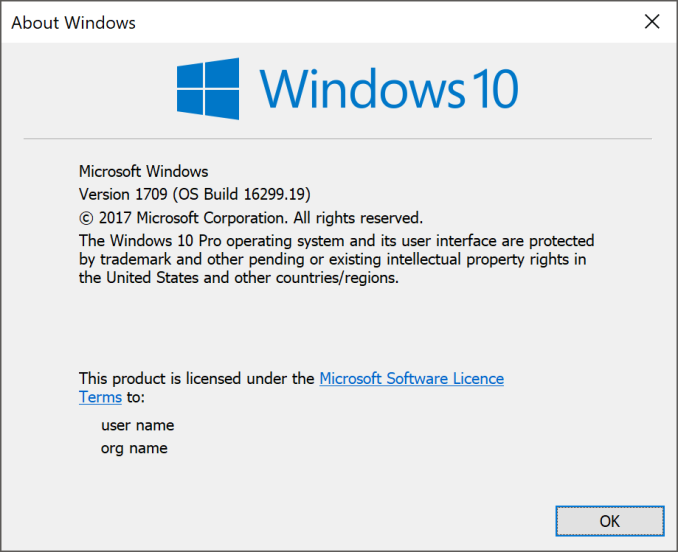The Windows 10 Fall Creators Update Feature Focus
by Brett Howse on November 10, 2017 8:00 AM EST
Windows 10 has finally settled into a groove. We are just over two years from the initial release of Windows 10. Part of the promise of Windows 10 was Windows as a service, or in other words, continual updates to Windows rather than monolithic version releases every couple of years. However, the haphazard schedule of feature updates was not pleasing to one stable customer of Microsoft’s. Businesses don’t love surprises, and they need time to plan ahead, and test, in order to deliver the vision that Microsoft has envisioned for Windows 10 going forward, so 2017 is the first year we get to see the new spring and fall updates, first with the Creators Update on April 11, 2017, and now the Fall Creators Update which became widely available on October 17, 2017.
The biannual release schedule still might be too aggressive for a lot of enterprises, but it’s a balancing act for Microsoft to keep the features coming for consumers, security updates coming for enterprise, and of course, keeping Windows 10 fresh in the eyes of everyone. Hopefully this new schedule works out though, since it’s nice to see fewer, smaller updates, rather than annual massive updates which may cause even more challenges.
| Windows 10 Version History | |||||
| Version | Version Number | Release Date | |||
| Windows 10 Original Release | 1507 | July 29, 2015 | |||
| November Update | 1511 | November 10, 2015 | |||
| Anniversary Update | 1607 | August 2, 2016 | |||
| Creators Update | 1703 | April 5, 2017 | |||
| Fall Creators Update | 1709 | October 17, 2017 | |||
And a smaller update is arguably what we’ve had for both of the 2017 releases for Windows, and that’s certainly not a bad thing. That’s not to take away from the many small changes and fixes under the hood, but more a fact that Windows 10 is solid, and stable, and updates only need to further smooth out some of the rough spots, and add a few new ideas for people to utilize. Windows 10 is now well known, with an official monthly active user base of over 500 million devices. It’s a solid number, despite being well under initial targets at launch.
With the Fall Creators Update, Microsoft has added quite a few new features, including some that missed out on the April update. They’ve taken the first step towards an improved OS and app design language since Windows 10 first launched, they’ve added more accessibility, more security, and finally added one of the top feature requests since Windows 10 launched. Let’s dig into the changes.












95 Comments
View All Comments
ddrіver - Sunday, November 12, 2017 - link
Oh, and don't get me started on the whole "other big OS makers collect everything about you at all times" or "other big OS makers don't bother to push hardware vendors to support phone hardware more than 2-3 years so you only get 1 or 2 years of major updates". M$ is the real problem here.BurntMyBacon - Wednesday, November 15, 2017 - link
@ddriver: "Oh, and don't get me started on the whole "other big OS makers collect everything about you at all times" or "other big OS makers don't bother to push hardware vendors to support phone hardware more than 2-3 years so you only get 1 or 2 years of major updates"."You want me to brush aside grievances from other vendors to make Microsoft look worse by lack of comparison? I REFUSE!!! Phones and tablets may be consumption devices that you are better off leaving anything sensitive far away from, but they've been pushed as computer replacements, they've been developed for as computer replacements, and much of the market uses them as computer replacements. People email on their phones, send sensitive messages on their phones, use their phones to facilitate payments, and even bank on their phones. You can either call out people for doing things the are not educated enough to know they shouldn't do on their phones, or you can call out the vendors for creating and environment designed to cater to these practices while siphoning data in the background. Not everyone can be a security expert and the average consumer has a difficult enough time with malicious entities sending bad emails, texts, and links through their messenger/social app of choice. They shouldn't have to consider companies like Google, Microsoft, and Apple as malicious entities.
@ddriver: "M$ is the real problem here."
No. If Microsoft fixed everything, it would not affect the issues you stated above with other vendors. Microsoft's actions are problematic for sure and they should not be excused just because vendor X, Y, and Z are worse. However, Microsoft's actions are a symptom of a larger problem created by the anti-privacy features built into iOS and Android devices when smartphones were rising in popularity and perpetuated by the lack of concern over these privacy invading features by the worldwide market. If enough people wholesale dropped these platforms (read: Significant loss of profits) for a less invasive platform despite the extra costs and inconveniences involved, then they would fix some of these problems. Unfortunately, not enough people seem to care.
cwolf78 - Friday, November 10, 2017 - link
Funny how there are a ton of comparison benchmarks including on this very site that completely refute your anecdotal claims.Mo3tasm - Friday, November 10, 2017 - link
You can benchmark how you want, but the "perceived" difference can't be benchmarked.mr_tawan - Saturday, November 11, 2017 - link
perception sometime is truth, some other time is illusion."Bullwinkle J Moose" - Friday, November 10, 2017 - link
"slower than Win7 or even Win8.1"----------------------------------------------
That depends.....
Bootup and shutdown speed is markedly faster but doing anything with your data is markedly slower
"Bullwinkle J Moose" - Friday, November 10, 2017 - link
I just again tested Windows 8.1 boot time at 14 seconds (that is normal)Win 10 Full Crapper Edition booted to the same PC with the same SSD in 5.3 seconds
ddriver - Friday, November 10, 2017 - link
Who cares about boot up speed, I boot up once every few months. Even a regular user doesn't boot up nowhere nearly enough to make a difference, when it craps over your entire usage."Bullwinkle J Moose" - Friday, November 10, 2017 - link
Regular users, sure, but I measure it and care because I have been known to boot several different operating systems from this machine in a single dayBIOS is set so that there is no primary boot device, which means that I can swap drives (or thumb drives) while the computer is rebooting and it will boot to whatever is currently plugged in instead of fumbling in the BIOS to change the boot order
Makes testing something new quick and easy, whether its in XP, Linux, Win 7, Win 8 or any Edition of Spyware Platform 10
"Bullwinkle J Moose" - Friday, November 10, 2017 - link
I also keep all the bootable SSD's on an external SATA to ESATA+USB Power cable so when I switch from SSD to thumb drive during a reboot, all I need to do is unplug the USB power to the SSD boot drive and plug in a thumb drive during reboot